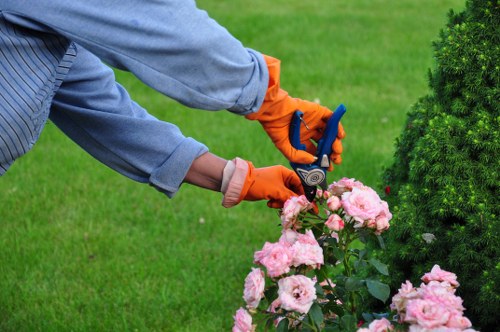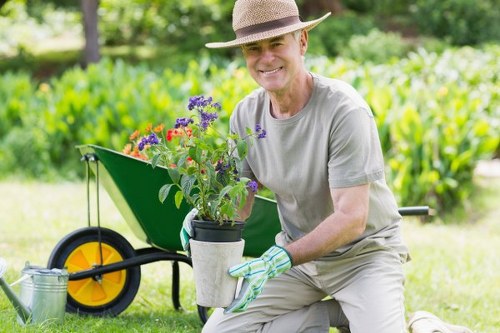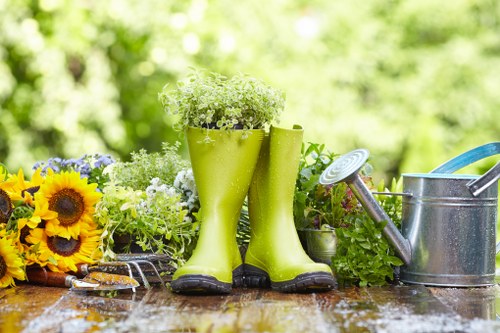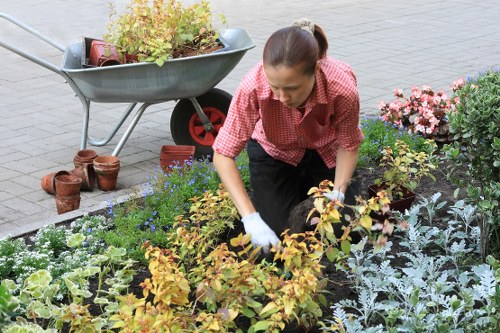Landscape Gardening in Garden Maintenance

Landscape gardening is an integral part of garden maintenance, encompassing the art and science of designing and maintaining outdoor spaces. It involves a combination of horticultural practices, aesthetic principles, and sustainable techniques to create environments that are both beautiful and functional.
At its core, landscape gardening aims to enhance the natural beauty of a garden while ensuring that it remains healthy and vibrant throughout the seasons. This requires a deep understanding of plant biology, soil health, climate conditions, and design principles.
Effective garden maintenance through landscape gardening involves regular care routines, strategic planning, and the implementation of best practices to prevent common issues such as pests, diseases, and invasive species.

Key Elements of Landscape Gardening
To master landscape gardening in garden maintenance, it's essential to focus on several key elements:
- Plant Selection: Choosing the right plants that thrive in your specific climate and soil conditions.
- Soil Management: Ensuring soil health through proper fertilization, aeration, and pH balance.
- Water Management: Implementing efficient irrigation systems and water conservation techniques.
- Design and Layout: Creating aesthetically pleasing arrangements that also promote plant health.
Each of these elements plays a vital role in maintaining a garden that is both sustainable and visually appealing.

Plant Selection and Placement
Choosing the right plants is fundamental to landscape gardening. It involves selecting species that are well-suited to your local climate, soil type, and sunlight conditions. Additionally, considering the growth habits and maintenance needs of each plant ensures a harmonious garden.
Proper plant placement enhances the garden's structure and flow. Taller plants are typically positioned towards the back or center, while shorter plants occupy the front or edges. This layering effect not only adds depth but also maximizes space efficiency.
It's also important to consider the bloom times of different plants to ensure year-round color and interest in your garden.

Soil Health and Fertilization
Healthy soil is the foundation of a thriving garden. Regular soil testing helps determine nutrient levels and pH balance, guiding appropriate fertilization practices. Organic matter, such as compost, improves soil structure, enhances moisture retention, and provides essential nutrients.
Mulching is another critical practice in soil management. It helps retain moisture, suppress weeds, and regulate soil temperature, creating a more favorable environment for plant roots.
Proper soil management not only supports plant growth but also contributes to the overall sustainability of the garden ecosystem.

Water Management Techniques
Efficient water management is essential for maintaining a healthy garden. Implementing drip irrigation systems minimizes water waste by delivering moisture directly to plant roots. Rainwater harvesting can also be a sustainable way to supply water during dry periods.
Using native plants that are adapted to the local climate reduces the reliance on supplemental watering. Additionally, mulching and proper soil management further enhance water retention, ensuring plants receive adequate hydration.
Conserving water not only benefits your garden but also contributes to environmental sustainability.

Pest and Disease Management
Proactive pest and disease management is crucial in garden maintenance. Regular monitoring helps identify potential issues early, allowing for timely intervention. Employing integrated pest management (IPM) strategies combines biological, cultural, and chemical controls to manage pests with minimal environmental impact.
Encouraging beneficial insects, such as ladybugs and butterflies, can naturally reduce pest populations. Additionally, maintaining plant health through proper care practices makes plants more resistant to diseases.
Effective pest and disease management ensures the longevity and productivity of your garden.
Seasonal Maintenance Tasks
Landscape gardening requires adapting maintenance practices to the changing seasons:
- Spring: Pruning, planting new shrubs and flowers, and preparing soil for growth.
- Summer: Regular watering, weeding, and monitoring for pests.
- Autumn: Clearing fallen leaves, mulching, and planting bulbs for spring.
- Winter: Protecting plants from frost, planning for the next season, and maintaining garden structures.
Adapting to seasonal changes ensures your garden remains healthy and resilient throughout the year.

Incorporating Sustainable Practices
Sustainable landscape gardening focuses on minimizing environmental impact while promoting biodiversity and resource conservation. This includes using native plants, reducing chemical usage, and implementing water-saving techniques.
Composting garden waste recycles nutrients back into the soil, reducing the need for synthetic fertilizers. Additionally, creating habitats for local wildlife supports ecological balance and enhances the garden's natural beauty.
Embracing sustainability in garden maintenance fosters a harmonious relationship between your garden and the environment.
Tools and Equipment for Effective Maintenance
Having the right tools is essential for efficient landscape gardening. Basic tools include pruners, shears, hoes, and rakes, each serving specific purposes in garden maintenance.
- Pruners: For trimming and shaping plants.
- Shears: Ideal for cutting smaller branches and precise shaping.
- Hoes: Useful for weeding and cultivating soil.
- Rakes: Great for clearing debris and leveling soil.
Investing in high-quality tools not only makes maintenance tasks easier but also ensures longevity and performance.

Design Principles in Landscape Gardening
Effective landscape gardening incorporates fundamental design principles to create visually appealing and functional outdoor spaces. Key principles include balance, contrast, harmony, and scale.
Balance involves distributing visual weight evenly across the garden, creating a sense of stability. Contrast adds interest by juxtaposing different colors, textures, and forms. Harmony ensures that all elements work together cohesively, while scale determines the appropriate size and proportion of plants and structures.
Applying these design principles enhances the overall aesthetics and usability of your garden.

Creating Functional Spaces
Designing functional spaces within your garden caters to various activities such as relaxation, entertainment, and gardening. Incorporating elements like seating areas, pathways, and focal points enhances the garden's usability and appeal.
Paths guide visitors through the garden, while seating areas provide spaces for rest and enjoyment. Focal points, such as sculptures or water features, draw attention and add character to the landscape.
Balancing functionality with aesthetics ensures that your garden serves both practical and visual purposes.

Benefits of Professional Landscape Gardening Services
Engaging professional landscape gardening services can significantly enhance garden maintenance. Experts bring specialized knowledge, experience, and resources to manage and improve your outdoor space effectively.
- Expertise: Professionals understand plant biology, soil health, and design principles, ensuring optimal garden health.
- Time-Saving: Outsourcing maintenance tasks frees up your time for other pursuits.
- Customized Solutions: Tailored maintenance plans address your garden's unique needs and challenges.
- Cost-Effective: Preventing issues through professional care can save money in the long run.
Investing in professional landscape gardening services ensures your garden remains a vibrant and inviting space throughout the year.
Long-Term Sustainability
Maintaining a sustainable garden involves practices that support long-term environmental health and resource conservation. This includes using renewable resources, minimizing waste, and promoting biodiversity.
Implementing composting, rainwater harvesting, and organic gardening techniques contribute to a sustainable garden ecosystem. Additionally, selecting a diverse range of native plants supports local wildlife and enhances ecological balance.
Sustainability in garden maintenance ensures that your outdoor space remains healthy and resilient for generations to come.
Enhancing Biodiversity
A biodiverse garden supports a wide variety of plant and animal species, contributing to a balanced ecosystem. Planting a diverse range of species attracts beneficial insects, birds, and other wildlife.
Creating habitats such as birdhouses, bee hotels, and water features fosters biodiversity and adds dynamic life to your garden. Biodiverse gardens are more resilient to pests and diseases, reducing the need for chemical interventions.
Enhancing biodiversity enriches the garden's natural beauty and ecological function.
Maintenance Scheduling and Planning
Effective landscape gardening requires meticulous scheduling and planning to ensure timely maintenance tasks. Developing a seasonal maintenance calendar helps manage activities such as planting, pruning, and fertilizing.
Using tools like garden journals or digital apps can assist in tracking maintenance schedules, plant growth, and seasonal changes. Proper planning ensures that maintenance tasks are performed consistently, promoting garden health and aesthetics.
Organized scheduling and planning streamline garden maintenance, making it more manageable and efficient.
Implementing Best Practices
Adhering to best practices in landscape gardening enhances garden maintenance outcomes. This includes regular monitoring, proactive care, and continuous learning.
- Regular Monitoring: Inspect plants and soil frequently to identify and address issues promptly.
- Proactive Care: Implement preventive measures such as mulching and proper watering to maintain plant health.
- Continuous Learning: Stay updated with the latest gardening techniques and trends to improve maintenance practices.
Best practices ensure that garden maintenance is effective, sustainable, and adaptable to changing conditions.

Integrating Technology in Garden Maintenance
Modern technology offers innovative solutions for efficient garden maintenance. Tools like smart irrigation systems, garden management software, and robotic mowers streamline maintenance tasks and enhance precision.
Smart irrigation systems use sensors to monitor soil moisture and weather conditions, optimizing watering schedules and conserving water. Garden management software helps track plant health, maintenance schedules, and resource usage.
Incorporating technology into landscape gardening simplifies maintenance, reduces labor, and promotes sustainable practices.

Smart Irrigation Systems
Smart irrigation systems utilize advanced technology to deliver precise amounts of water based on real-time data. This reduces water waste, lowers utility bills, and ensures plants receive adequate hydration.
These systems can be controlled remotely via smartphones, allowing for adjustments based on weather forecasts and garden needs. Integrating smart irrigation with other garden technologies enhances overall maintenance efficiency.
Adopting smart irrigation leads to a more sustainable and manageable garden environment.
Garden Automation
Automation in garden maintenance can significantly reduce manual labor and increase precision. Robotic mowers, automated feeders, and sensor-based lighting systems are examples of garden automation technologies.
Robotic mowers maintain consistent grass height without the need for manual cutting, while automated feeders ensure pets and wildlife receive regular nourishment. Sensor-based lighting adjusts based on daylight, enhancing garden aesthetics and security.
Embracing garden automation improves maintenance efficiency and allows for greater focus on garden design and enjoyment.
Conclusion: The Importance of Landscape Gardening in Garden Maintenance
Landscape gardening is a vital component of effective garden maintenance, blending aesthetic appeal with practical care. By focusing on key elements such as plant selection, soil health, water management, and sustainable practices, garden owners can create and maintain beautiful, resilient outdoor spaces.
Incorporating professional services, adhering to best practices, and leveraging technology further enhance maintenance efforts, ensuring gardens remain vibrant and healthy year-round.
Investing time and resources into landscape gardening not only elevates the appearance of your garden but also fosters a sustainable and enjoyable environment for all.
Contact us today to transform your garden with expert landscape gardening services tailored to your unique needs.